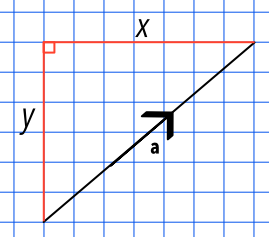A column vector gives both magnitude and direction. The magnitude, or size, of a vector is written as |a| (called modular a, when the sign is ignored). When considering just the size (magnitude) of the vector, the direction is irrelevant.
Because a column vector uses rectangular components (ie at right angles) the magnitude of the vector can be obtained using Pythagoras: for a vector `((x),(y))`, this is `sqrt(x^2 + y^2)`.

What is the magnitude of the resultant vector `3bb(g) + 2bb(h)`, when `bbg = ((2),(5))` and `bb(h) = ((1),(-1))`?
Give your answer to 2 decimal places.
The resultant vector is `((3 xx 2 + 2 xx 1),(3 xx 5 + 2 xx -1)) = ((8),(13))`
Using Pythagoras: `a^2 = b2 + c^2`
= `sqrt(8^2 + 13^2)`
= 15.264
=15.26 (2dp)
Answer: 15.26
Vector c is defined as `((7),(11))`.
What is the magnitude of c?
Use Pythagoras to determine the magnitude:
magnitude = `sqrt(7^2 + 11^2)`
= 13.038
Answer: 13.04 (to 2dp)
See also Pythagoras